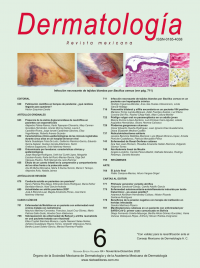Bilateral panuveitis and syphilitic secundarism in an HIV positive patient.
Dermatol Rev Mex. 2020; 64 (6): 716-721.
Mariana Torres Landa-Márquez,1 Adán Fuentes-Suárez,2 Luz Elena Concha-Del Río,3 Rashel Cheja-Kalb,3 Allan Collura-Merlier4
1 Medicina Interna, Hospital Ángeles Lomas, Estado de México.
2 Dermatología, Hospital General Dr. Manuel Gea González, Ciudad de México.
3 Enfermedades inflamatorias oculares.
4 Microcirugía del segmento anterior.
Asociación para Evitar la Ceguera en México, México.
Resumen
ANTECEDENTES: La infección por Treponema pallidum es una de las enfermedades de transmisión sexual más prevalentes en el mundo, la incidencia está a la alza predominantemente en grupos en alto riesgo, como en inmunosuprimidos y seropositivos, entre otros. El secundarismo sifilítico comprende afecciones complejas que implican varios aparatos y sistemas, incluido el globo ocular y en 80% de los casos la piel. Las recomendaciones para el diagnóstico de la enfermedad incluyen las pruebas treponémicas y no treponémicas, sumando en los últimos años la identificación por reacción en cadena de polimerasa (PCR). El tratamiento contra la panueveítis sifilítica debe ser el mismo esquema prescrito en el diagnóstico de neurosífilis.
CASO CLÍNICO: Paciente masculino de 26 años de edad, como único antecedente relevante, era seropositivo desde 2017, sin tratamiento. Inició su padecimiento dos meses previos con disminución de la agudeza visual, ojo rojo y epífora en el ojo derecho y fotofobia en el izquierdo. También se documentó dermatosis diseminada a las regiones palmoplantares de manera bilateral, simétrica, constituida por placas infiltradas color marrón, circulares, confluentes y con escama fina en arreglo cartográfico.
CONCLUSIONES: Debe tenerse en consideración la panuveítis bilateral como diagnóstico diferencial de distintas enfermedades de transmisión sexual o infecciosas, como tuberculosis, enfermedad de Lyme, sarcoidosis y enfermedad de Vogt-Koyanagi-Harada, entre otras, sobre todo en pacientes seropositivos.
PALABRAS CLAVE: Sífilis; Treponema pallidum; panuveítis bilateral.
Abstract
BACKGROUND: One of the most prevalent sexually transmitted diseases is syphilis, caused by Treponema pallidum; there is a rising incidence of the disease predominantly in high-risk populations such as immunosuppressed and HIV-positive patients. Syphilitic secundarism regards different and complex entities that affects several organs, including the eyes, and in 80% of times, the skin. Diagnosis is made with treponemal and non-treponemal tests, and in recent years the PCR (polymerase chain reaction) has gained importance in the field. Treatment of syphilitic panuveitis should be the same than that prescribed against neurosyphilis.
CLINICAL CASE: A 26-year-old male patient, as the only relevant history, was seropositive since 2017, without treatment. He started his condition two months before with decreased visual acuity, red eye and epiphora in the right eye, and photophobia in the left. Dermatosis disseminated to the palmoplantar regions was also documented bilaterally, symmetrically, consisting of brown, circular, confluent infiltrated plaques with fine scales in cartographic arrangement.
CONCLUSIONS: Bilateral panuveitis should be considered as differential diagnosis of several sexually transmitted or infectious diseases, such as tuberculosis, Lyme’s diseases, sarcoidosis and Vogt-Koyanagi-Harada disease, among others, especially in seropositive patients.
KEYWORDS: Syphilis; Treponema pallidum; Bilateral panuveitis.

